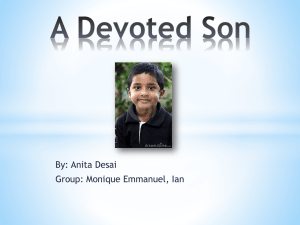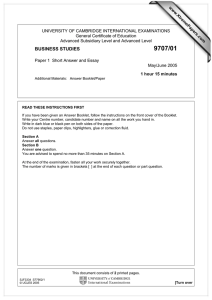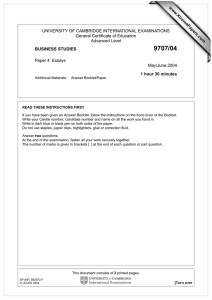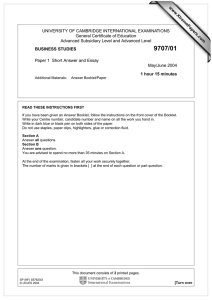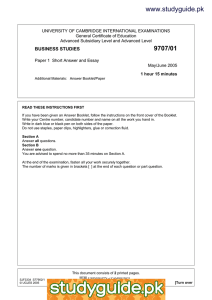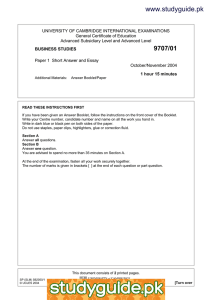www.XtremePapers.com UNIVERSITY OF CAMBRIDGE INTERNATIONAL EXAMINATIONS General Certificate of Education Advanced Level 9707/32
advertisement
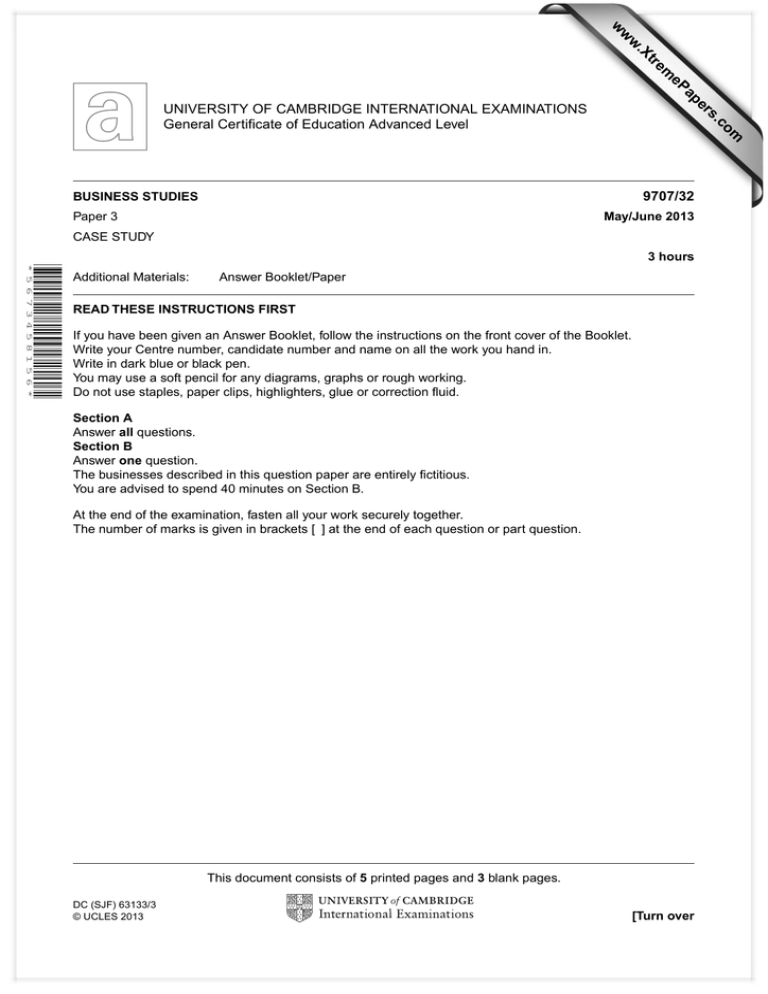
w w ap eP m e tr .X w om .c s er UNIVERSITY OF CAMBRIDGE INTERNATIONAL EXAMINATIONS General Certificate of Education Advanced Level 9707/32 BUSINESS STUDIES Paper 3 May/June 2013 CASE STUDY 3 hours * 5 6 7 3 4 5 8 1 5 6 * Additional Materials: Answer Booklet/Paper READ THESE INSTRUCTIONS FIRST If you have been given an Answer Booklet, follow the instructions on the front cover of the Booklet. Write your Centre number, candidate number and name on all the work you hand in. Write in dark blue or black pen. You may use a soft pencil for any diagrams, graphs or rough working. Do not use staples, paper clips, highlighters, glue or correction fluid. Section A Answer all questions. Section B Answer one question. The businesses described in this question paper are entirely fictitious. You are advised to spend 40 minutes on Section B. At the end of the examination, fasten all your work securely together. The number of marks is given in brackets [ ] at the end of each question or part question. This document consists of 5 printed pages and 3 blank pages. DC (SJF) 63133/3 © UCLES 2013 [Turn over 2 MOUNTAIN TOURS (MT) Rakesh is a skilled mountain climber. When he left school he decided to combine a love for mountain climbing with his aim of working for himself. He set up a private limited company called Mountain Tours. It offered guided tours – or treks – in the mountain regions of his country to small groups of tourists. Rakesh was resourceful and he was prepared to work long hours to make sure that his customers had a unique, good-value holiday. His excellent communication skills proved important when he applied successfully to his bank for a loan. Rakesh was also lucky. He started his business at a time when the tourist industry in his country was expanding and supported by Government grants. In its first years of trading MT achieved Rakesh’s two main objectives for the business – survival and an income sufficient to give him independence. Rakesh set his aim higher As MT became established in its niche market, Rakesh became more confident about expanding the business profitably. He did this in two ways. Firstly, he recruited four mountain guides and trained them to operate MT's well-known specialist treks. Secondly, he purchased three mountain guest-houses which offered basic accommodation and local food to trekking tourists. He used a bank loan and retained profits to finance this. The expansion was very successful because of the quality of employees Rakesh was able to recruit. He chose mountain guides who shared his passion for his country and the natural world. In addition, he offered his guides and guest-house managers a profit sharing scheme. All of the new MT employees understood the culture that Rakesh was trying to create within MT. MT is now an integrated travel business As a result of steady growth MT now has 50 mountain guides, 35 guest-houses and its own transport division with a fleet of tourist buses. It also leases 4 aircraft to fly in tourists and operate sight-seeing air tours. Two of these aircraft are old and have reached the end of their leasing agreement. Rakesh has the following two options. 5 10 15 20 25 Option X. Take out a 5 year lease on 2 new aircraft, with maintenance costs paid for by the leasing company. The cost of painting the aircraft in MT’s colours would be $200 000. This option has a discounted payback period of 1 year 4 months and a net present value of $591 500. Option Y. Buy 2 aircraft that are already 4 years old. These could be resold for an estimated residual value of 40% of their purchase price after five years. MT would pay to maintain these aircraft. 30 Appendix 1 shows the expected net cash flows from these two options. The net cash flows include leasing charges or the interest cost of capital used to buy the aircraft. Relocating to new airport – this year or next year? MT’s aircraft operate from the capital city’s airport. This is small, has poor facilities for tourists and is closing in 2015. A new airport has just been completed 50 kilometres away. MT has to decide when to relocate its operations to this new airport – this year or wait until next year? It is now the end of May and the tourist season starts in 7 weeks time. 35 If MT starts relocating now, its offices at the old airport will be closed. There will then be a risk that MT’s resources will not be transferred quickly enough to the new airport for the start of the seasonal tourist boom. If this happens and MT arranges for its aircraft to land at the new airport then there may be no MT staff or facilities to greet the tourists. There could be big compensation payments to MT’s customers if delays in travel occur. MT’s Operations Director has produced the data in Appendix 2 to help decide whether to start the relocation this year. 40 © UCLES 2013 9707/32/M/J/13 45 3 Marketing MT 40% of MT’s customers are tourists who have used MT before and 60% are new customers attracted by the company’s website. Holidays are booked either online or by telephone. The recruitment of workers operating the telephones is outsourced to an employment agency. Its selection process is based on a telephone interview with applicants. Training of new recruits takes one morning. These workers have no future job opportunities elsewhere in MT even if they have an interest in tourism and mountain trekking. Rakesh wants to change the way in which telephone staff are recruited, selected and motivated; but he has been too busy. The latest employee performance data for this group of workers may convince Rakesh to make employment issues a higher priority – absenteeism and turnover are high and customer complaints about the telephone staff are increasing. Rakesh takes all of the strategic marketing decisions. After 15 years in the business he believes that he has a good understanding of the seasonal factors that affect demand and the cyclical impact of economic fluctuations. Only once in its history has MT faced substantial excess capacity in guides, guest-houses and transport – when the country’s currency appreciated rapidly for a six month period. Rakesh has grown confident in his ability to forecast market changes. He boasted to the Board of Directors that: ‘Sales forecasting techniques are a waste of time and resources for a business such as MT. I can predict trends in the tourist market better than any mathematician!’ Future strategic options Rakesh is ambitious for further business growth. He is considering the following two strategic options. Strategy A: Peak Hotels (PH) group of hotels The owners of PH recently asked Rakesh if he would be interested in buying their business. The hotels are profitable but they have problems that Rakesh is aware of. The hotels are in need of renovation and the estimated cost of this is $4 m. The beliefs and attitudes of the hotel managers lead them to being task focused. Hotel employees have short-term contracts. Guests often complain about unexpected charges which appear on their bills and the misleading website pictures of the hotels. Rakesh realises that this is a great opportunity to expand MT, but he is worried about how the problems of different culture and management styles between MT and PH could be solved. Strategy B: Expansion of tourist trek business into other countries One of MT’s employees has recently returned from a trip to country R, located 2000 kilometres from the country MT currently operates in. The employee is enthusiastic about the opportunities that exist for MT in country R. ‘The mountains are fantastic, the tourist industry has just restarted after 5 years of political instability and there are no major trekking or holiday firms yet established’ he reported to MT’s Board of Directors. 50 55 60 65 70 75 80 Rakesh asked a management consultant to analyse these growth options and to produce data that could help him make the strategic choice between them. (See Appendix 3). © UCLES 2013 9707/32/M/J/13 [Turn over 4 Appendix 1: Replacement aircraft – Forecasted net cash flows for the two financing options Year Option X: Leasing new aircraft ($000) Option Y: Purchasing second-hand aircraft ($000) 0 (200) (2000) 1 150 700 2 250 700 3 250 600 4 200 500 5 200 350 (not including residual value) 10% Discount factors: Year 1: 0.91; Year 2: 0.83; Year 3: 0.75; Year 4: 0.68; Year 5: 0.62. Appendix 2: Activities involved in transferring MT operations to new airport Activity Preceding activity(ies) Description of activity Duration (weeks) A – Arrange lease of new airport office 2 B – Recruit new airport staff 2 C – Prepare new promotional literature and stationery with new address 3 D A Equip new airport office 1 E D Relocate computers and other equipment 2 F B Train new staff 4 G C Check promotional material and send this to MT offices before new airport office opens 1 H E, F Test MT operations at new airport 1 Appendix 3: Data to be used when choosing between strategies A and B Strategy A Strategy B Decision tree data: Expected net values (after 5 years of operation) $5 m $6 m Internal rate of return on investment (after 5 years of operation) 12% 15% Market penetration (hotel market) – low risk Market development – medium risk 13 : 8 Culture of PH hotels 11:12 Communication with workers abroad Ansoff Matrix classification Force field analysis: Forces for change : Forces against change Most important force against change: © UCLES 2013 9707/32/M/J/13 5 Section A Answer all questions in this section. 1 Analyse the main strengths of MT during its early years of trading. 2 (a) Refer to Appendix 1. Calculate for option Y at a 10% rate of discount: [10] (i) discounted payback period [3] (ii) net present value. [3] (b) Using your results from 2(a) and other information, recommend to MT whether to lease new aircraft or purchase second-hand aircraft. [10] 3 Evaluate the extent to which you agree with Rakesh that ‘sales forecasting techniques are a waste of time and resources for a business such as MT’ (lines 62–63). [16] 4 (a) (i) Refer to the data in Appendix 2. Draw a network diagram for the relocation of MT’s operations to the new airport. [6] (ii) Calculate the earliest start times (EST) and latest finish times (LFT) of each activity. [5] (iii) State the duration of the critical path. [1] (b) Using your answers from 4(a) and other information, assess whether MT should relocate operations this year or wait until next year. [10] 5 Discuss how Rakesh could improve the performance of his telephone marketing employees. [16] Section B Answer one question from this section. 6 Recommend to Rakesh whether he should choose strategy A or strategy B (lines 68–84). Your answer should include an evaluation of the data in Appendix 3. [20] 7 Evaluate how Rakesh could change the culture of the PH group if MT takes over this business. [20] © UCLES 2013 9707/32/M/J/13 6 BLANK PAGE © UCLES 2013 9707/32/M/J/13 7 BLANK PAGE © UCLES 2013 9707/32/M/J/13 8 BLANK PAGE Permission to reproduce items where third-party owned material protected by copyright is included has been sought and cleared where possible. Every reasonable effort has been made by the publisher (UCLES) to trace copyright holders, but if any items requiring clearance have unwittingly been included, the publisher will be pleased to make amends at the earliest possible opportunity. University of Cambridge International Examinations is part of the Cambridge Assessment Group. Cambridge Assessment is the brand name of University of Cambridge Local Examinations Syndicate (UCLES), which is itself a department of the University of Cambridge. © UCLES 2013 9707/32/M/J/13
